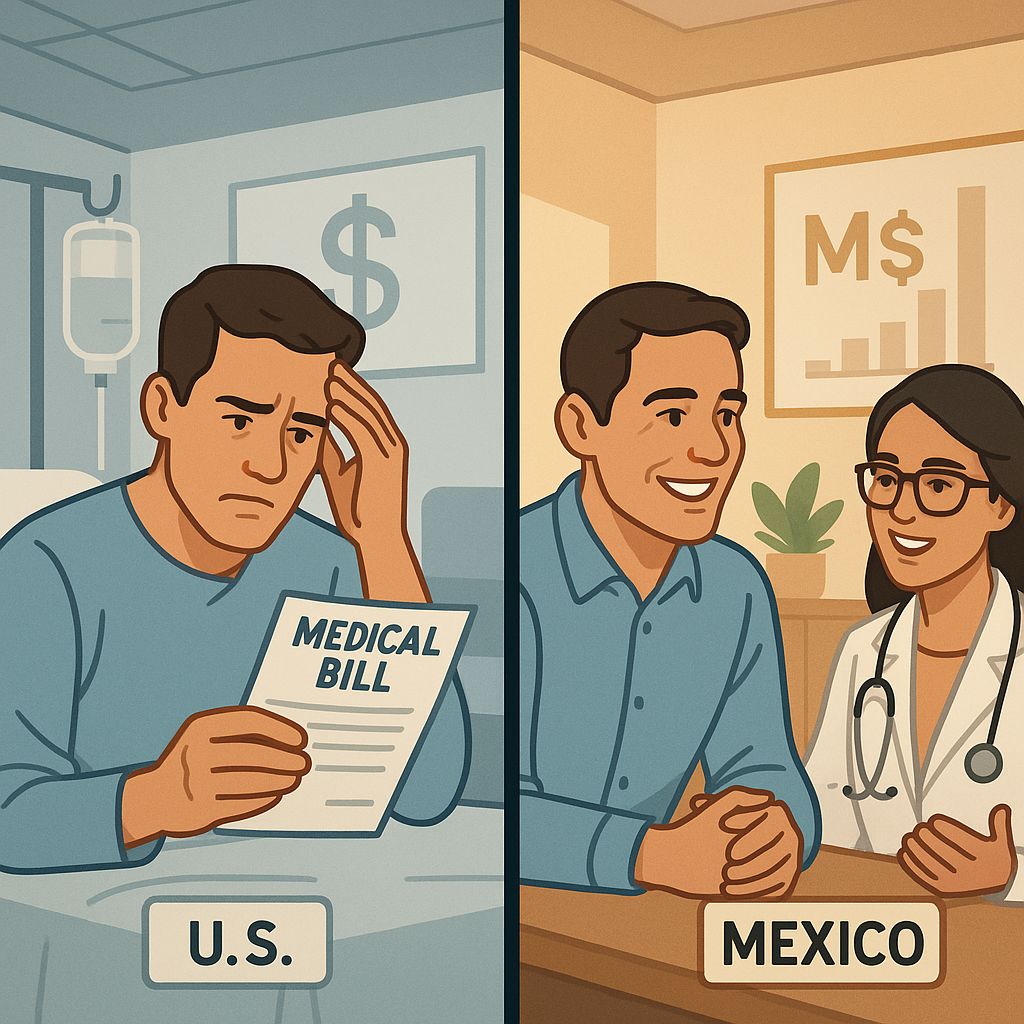summary
The real cost of healthcare in the United States compared to Mexico has become a significant topic of discussion, reflecting broader concerns about affordability, access, and quality within the healthcare systems of both countries. The United States, known for its high expenditure on healthcare, spends approximately $13,432 per capita, which is over $3,700 more than any other high-income nation. This stark contrast raises questions about the efficiency and accessibility of the American system, particularly as about 10% of its population remains uninsured despite various public insurance programs like Medicare and Medicaid[1][2].
In contrast, Mexico’s healthcare system features a mix of public and private options, offering services that are generally more affordable. While healthcare is constitution- ally guaranteed to all citizens, many opt for private care due to perceptions of superior quality and shorter wait times. The cost of procedures and medications in Mexico is often significantly lower than in the U.S., making it an attractive destination for medical tourism, where patients seek affordable alternatives for treatments[3][4][5].
The disparities between the two systems are not merely financial; they also encompass health outcomes and overall quality of care. Despite higher spending, the U.S. often lags in health outcomes compared to Mexico and other comparable nations, prompting ongoing debates regarding healthcare reform and cost control[6][7]. The accessibility of healthcare services in Mexico varies greatly between urban and rural areas, with ongoing efforts to improve coverage and quality through reforms like the Seguro Popular and its successors[3].
Controversies surrounding healthcare in both countries highlight significant issues, including the burden of medical debt in the U.S. and the risks associated with medical tourism in Mexico, such as inadequate follow-up care and varying quality standards- [7][8]. As patients increasingly seek solutions across borders, understanding the complexities of healthcare costs and outcomes in the U.S. and Mexico remains crucial for informed decision-making.
Healthcare System in the U.S.

The healthcare system in the United States is characterized by a mix of private and public insurers, with a significant reliance on employer-sponsored private insurance for the majority of the population. This system has become a prominent concern for many Americans due to its high costs and varying quality of care. The U.S. spends more on healthcare per person than any other wealthy country, which raises questions about the efficiency and accessibility of the system[1][9].
Overview of Coverage
The U.S. healthcare framework includes several key programs, notably Medicare and Medicaid. Medicare serves those aged 65 and older, while Medicaid provides coverage for low-income families and individuals with disabilities. Despite these programs, approximately 10% of Americans remain uninsured, which is a significant issue compared to other developed nations where universal healthcare is more com- mon[9][10]. Employer-sponsored insurance often ties health benefits to employment, complicating job mobility and care access for those who may become ill or lose their jobs[9].
Cost and Access
The high costs of healthcare in the U.S. are attributed to various factors, including high prices for services and an increased volume of high-tech medical procedures. This has resulted in the U.S. being the only wealthy nation without universal healthcare access, leading to financial burdens for many individuals and families[1][11]. Further- more, the complexity of the system often necessitates additional private insurance for services not covered by basic plans, exacerbating the financial strain on patients[10].
Comparative Analysis
Healthcare Spending Trends
The United States exhibits a significantly higher level of healthcare expenditure compared to Mexico and other comparable countries. In 2023, per capita health expenditures in the U.S. reached $13,432, which is over $3,700 more than any other high-income nation, while the average in comparable countries was approximately
$7,393[2]. This disparity highlights a major difference in healthcare allocation and economic resources devoted to health services between the two nations.
Private vs. Public Healthcare
The increased reliance on private healthcare in Mexico can be attributed to perceptions regarding the quality and accessibility of public healthcare services. Many patients believe that private services offer superior care, leading to shorter wait times, less crowding and higher-quality equipment[3]. In contrast, public healthcare in Mexico is sometimes provided at no cost, yet patients often opt for private services despite the associated out-of-pocket costs.
In the U.S., healthcare spending is predominantly driven by inpatient and outpatient care, which accounted for a difference of $4,531 per person compared to similar countries[6]. The overall quality of care, particularly in areas such as prenatal services, remains a topic of debate in both countries.
Cost Breakdown
In the U.S., the substantial costs are further dissected into various components: ad- ministrative costs, inpatient and outpatient services, and prescription drugs. Admin- istrative expenditures alone can account for up to 34% of healthcare spending, which is notably higher than in Mexico[12]. In Mexico, costs associated with hospitalization and other health services have remained relatively stable since the introduction of health reforms in 2003[3]. Despite the higher overall spending in the U.S., the focus on specific categories such as retail prescription drugs has led to critical discussions regarding the sustainability of healthcare financing in the country[6].
Health Outcomes
Despite the high spending on healthcare in the U.S., health outcomes often lag be- hind those of Mexico and other comparable nations. Factors such as socioeconomic status, access to care and the effectiveness of health policies play significant roles in influencing these outcomes[6]. In Mexico, public health initiatives and reforms have aimed to improve health services accessibility, while in the U.S., discussions surrounding healthcare reform and cost control continue to be contentious[1].
Healthcare System in Mexico
The healthcare system in Mexico is a multifaceted framework that encompasses public institutions, private hospitals and clinics and private physicians. Its structure is primarily influenced by individual’s employment statuses, with various insurance programs designed to provide coverage based on one’s job situation.
According to the Mexican constitution, every citizen is entitled to free access to healthcare and medication, a principle that was previously embodied by the Instituto de Salud para el Bienestar (INSABI), which was discontinued in 2023[13][3].
Public and Private Healthcare
Mexican healthcare is characterized by a significant presence of both public and private sectors. The public sector includes the Instituto Mexicano del Seguro Social (IMSS), which serves employed citizens and their dependents through a tripartite funding system involving employees, employers, and the federal government. Over 65 million people are covered under the IMSS programs[3]. The largest public health- care institution, the Secretariat of Health, operates 809 hospitals nationwide, while IMSS maintains 279 affiliated hospitals. Additionally, the ISSSTE provides services to government employees with its own network of 115 hospitals[3].
Despite the constitutional guarantee of free healthcare, many individuals opt for private healthcare services due to perceived limitations in the public sector regarding accessibility and quality. Private facilities often offer shorter wait times, less crowding, and a higher standard of patient-provider interaction, leading many to rely on them even when public services are available at no cost[4][3]. Private hospitals in Mexico are reported to have quality standards comparable to those in the United States[5].
Accessibility and Coverage
The accessibility of healthcare services in Mexico varies significantly, particularly between urban and rural areas. Urban populations may experience conflicts related to service delivery due to high demand, while rural communities face challenges such as sparse institutional resources and a lack of specialized care[3]. In response to these issues, the introduction of Seguro Popular in 2003 marked a significant expansion in healthcare coverage, particularly for uninsured individuals[1]. By 2020, this program was replaced by INSABI, which in turn was replaced by IMSS-Bienestar in 2023, continuing the effort to provide comprehensive coverage across various demographic groups[3].
Quality of Care
While the quality of healthcare services in Mexico can be high, especially in large cities like Mexico City, Guadalajara, and Monterrey, disparities exist. For example, rural areas may experience a lack of essential services and specialized care, particularly in mental health[3][11]. The cost of medical care is notably lower in Mexico compared to the United States and Canada, with medications often costing nearly half as much[4][5]. This affordability, coupled with the availability of private medical packages that include accommodations, attracts many medical tourists seeking quality care at reduced prices[5].
Impacts on Patients
Medical tourism to Mexico has significant impacts on patients seeking healthcare solutions, especially from the United States and Canada. As healthcare costs in the U.S. continue to soar—averaging $13,432 per person in 2023, which is over
$3,700 more than any other high-income nation[2]—patients are increasingly drawn to Mexico for more affordable treatment options. This shift not only provides financial relief but also addresses issues related to long waiting times for medical procedures in the U.S.[7][14].
Economic Benefits
The primary economic benefit for patients traveling to Mexico for medical care is the drastically reduced cost of treatments. For instance, common procedures such as hip replacements can cost approximately $28,167 in the U.S., while in Mexico, the same procedure can be performed for a fraction of that price[15]. The affordability of medical services in Mexico enables patients to access necessary care without the financial burden often associated with healthcare in the United States[5]. Additionally, the ability to combine medical procedures with a vacation further enhances the appeal of medical tourism, allowing patients to recuperate in a more relaxed environment while exploring Mexico’s rich culture and landscapes[16].
Quality of Care
Patients seeking medical care in Mexico often find that they receive high-quality services, with many healthcare professionals trained in the U.S. or other advanced medical systems. This perception is supported by the presence of state-of-the-art medical facilities in the country[8]. While some may express concerns regarding the quality of care compared to that in the U.S., many medical tourists report satisfactory experiences, highlighting the expertise of Mexican healthcare providers and the modernity of medical equipment used[14].
Risks and Considerations
Despite the advantages, patients must also consider the potential risks associated with receiving care abroad. These include the possibility of inadequate follow-up care, challenges related to language barriers, and varying standards of healthcare regulation between countries[8][5]. Additionally, patients may face complications if they need to seek follow-up care in the U.S. after receiving treatment in Mexico.
Patients should conduct thorough research and consult with healthcare professionals to mitigate these risks before proceeding with medical tourism[7][5].
References
- : How Does the U.S. Healthcare System Compare to Other Countries?
- : 14 Countries with Better Healthcare Than the United States – Expatsi
- : Comparing International Health Care Systems | PBS News
- : Health Insurance and Healthcare in Mexico Explained – InterNations
- : How does health spending in the U.S. compare to other countries?
- : Healthcare in Mexico – Wikipedia
- : What drives health spending in the U.S. compared to other countries?
- : Why administrative health care costs are high and how they can be …
- : In review: the healthcare framework in Mexico – Lexology
- : Mexico’s Healthcare System – International Citizens Insurance
- : Complete Guide to Medical Tourism in Mexico
- : why thousands of Americans cross to Tijuana for medical treatment
- : Medical tourism in Mexico is rising among Americans – NPR
- : 6 Reasons Healthcare Is So Expensive in the U.S. – Investopedia
- : A Closer Look at Medical Tourism in Latin America
- : Mexico | Medical Tourism



